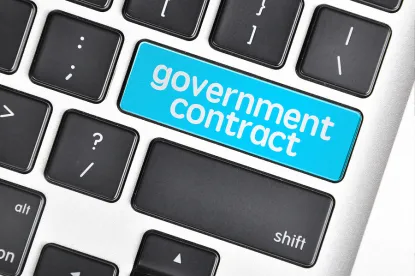On May 2, 2019, the General Services Administration (“GSA”) and the Office of Management and Budget (“OMB”) finally released their Phase 2 Implementation Report (the “Phase 2 Report”) for “Procurement Through E-Commerce Portals,” as directed by Section 846 of the National Defense Authorization Act for Fiscal Year 2018 (“FY 2018 NDAA”).[1]
GSA/OMB offered a sneak preview of the Phase 2 Report at an Industry Day held on December 12, 2018, during which GSA/OMB revealed their intent to proceed with a proof of concept contract utilizing only the E-Marketplace model. Industry pushback against a single model proof of concept was both quick and severe and, coupled with the lengthy delay issuing the Phase 2 Report, many wondered whether GSA/OMB were reevaluating their proposed approach.
Much to the dismay of E-Commerce and E-Procurement portal providers, GSA/OMB stayed the course. Their Phase 2 Report included two primary conclusions: (1) testing the E-Marketplace model exclusively during the proof of concept phase is the most practical approach, and (2) raising the Micro-Purchase Threshold (“MPT”) to $25,000 for 5 years exclusively for purchases made through the approved portals is necessary to maximize the effectiveness of the proof of concept.
While the Phase 2 Report provides these two concrete conclusions, ultimately, the Report raises more questions than answers. And what better way to address these than a good old-fashioned Top 10 List. So, without further ado, here’s our Top 10 List[2] of questions from the Phase 2 Report:
Question 10: Will the proof of concept survive legal challenge? Given the continued pushback from E-Commerce and E-Procurement portal providers against using a single model for the proof of concept, it’s a safe bet we’ll see some protest activity when GSA releases the solicitation. During a recent event hosted by the Coalition for Government Procurement, GSA/OMB announced their intent to release the solicitation by the end of Q3 2019. At that point, E-Commerce and E-Procurement portal providers could protest at the Government Accountability Office (“GAO”) or the Court of Federal Claims (“COFC”). A protest in either forum will delay GSA’s award of contracts.
Question 9: Will the proof of concept expand beyond the E-Marketplace model? In the Phase 2 Report, GSA repeatedly states its intention to expand the program beyond the E-Marketplace model eventually, but focuses on the single model exclusively for the proof of concept. Protest filings, if any, could delay the Government’s timeline.
Question 8: How many portal providers will be selected for the proof of concept? The Phase 2 Report kicks the can down the road in terms of deciding how many portal providers it anticipates selecting. GSA representatives have stated the agency intends to award multiple contracts, yet only time will tell whether program requirements are broad enough to encompass multiple commercial portal providers.
Question 7: How will portals address cybersecurity and supply chain risk management? The Phase 2 Report states that “[i]t is not GSA’s role, nor the intention of the proof of concept, to ‘solve’ all supply chain security issues…[and] buyers will continue to be responsible for ensuring they are receiving genuine products.” Further, the Phase 2 Report states that while potential portal providers “have robust cybersecurity practices and solutions, few were willing to publicly share their proprietary capabilities.” Here again, only time will reveal how Government end users, the E-Marketplace providers, and the suppliers can come together to answer these supply chain questions.
Question 6: Will the E-Marketplace model result in lower prices? In the Phase 2 Report GSA revealed it will charge a fee for administering the portals program (similar in concept to the Industrial Funding Fee it charges for the Schedules program). The resulting program, therefore, contemplates a 2-layered fee structure, wherein the portal provider is paid a hosting fee AND GSA is paid a fee to administer the program. GSA does not address, however, the potential impact on total price to the Government customer.
Question 5: Will value or quality matter? With each passing phase, the portals program seems more-and-more destined to focus on Lowest Priced Technically Acceptable (“LPTA”) procurements, despite the language in the FY 2019 NDAA designed to limit the Government’s reliance on these procurement models. While the portals are required to include a customer rating/review system, the system is designed to draw customers to the lowest price options, at times at the expense of quality. It remains to be seen whether GSA can maintain quality of products while emphasizing the Government’s total value responsibilities.
Question 4: Will Congress grant GSA/OMB’s request to raise the MPT to $25,000 exclusively for purchases made through the portals? Those paying close attention probably recognized that GSA/OMB requested this legislative change in the Phase 1 Plan, only to be denied by Congress. This time may be different, though. On May 17, 2019, Congressman Mac Thornberry (R-TX), Ranking Member of the House Armed Services Committee, released draft legislation titled “Continuing Acquisition Reform Act of 2019,” for consideration as part of the NDAA for Fiscal Year 2020. If passed, the legislation would increase the MPT to $25,000, through the end of Fiscal Year 2023 (September 30, 2023), for purchases made through a GSA-approved portal. If at first you don’t succeed…
Question 3: How will the portals impact the GSA Schedules program?
Congress has put GSA in an interesting spot – administering a program specifically designed to address the shortcomings of its Schedules program. As we’ve discussed previously, GSA has walked this tightrope by focusing the portals program on purchases under the MPT (for now, $10,000), despite statutory authority to handle transactions up to the Simplified Acquisition Threshold ($250,000). Yet GSA/OMB’s request to raise the Micro-Purchase Threshold may inadvertently create parallel competition universes where different rules apply. For the same hypothetical $17,000 purchase, under the Schedules program, all existing procurement rules would apply (including the Trade Agreements Act), while through an E-Marketplace portal, no procurement rules would apply. GSA/OMB have stated publicly they do not believe there is any objective evidence the portals program will impact the Schedules program, but that position simply does not pass the “straight-face” test.
Question 2: Will services be added to the E-Marketplaces? Under Section 846, GSA does not have statutory authority to sell services through the portals program. Interestingly, the Phase 2 Report notes that, while “GSA does not intend to seek authority that goes beyond COTS at this time,” GSA “learned that agencies were interested in buying services through the portals.” The Report concludes that GSA “welcomes the opportunity to dealing with Congress about conducting further research regarding the feasibility of adding services to the platforms as the program expands above the micro-purchase threshold.” Reading the tea leaves, it appears to be only a matter of time until GSA seeks to add services to the portals program.
Question 1: Will restrictions on the use of transaction data hurt the program? As its number 1 ranking suggests, this is the most important question left unanswered by the Phase 2 Report. In the Report, GSA noted it heard “sharply different messages” concerning the use of transaction data. Section 838 of the 2019 NDAA prohibits portal providers from using transaction data to obtain a competitive advantage. This language was passed at the urging of potential suppliers concerned portal providers will use the transaction data to gain a competitive advantage, but the language did not include the compliance and enforcement mechanisms suppliers sought. In response, proponents of E-Marketplaces argue access to the transaction data is critical to ensuring effective operation of the program. As it currently stands, both suppliers and portal providers are unhappy, and with GSA stating they intend to stay the course, we’re left to wonder whether GSA will find enough companies willing to move forward with the program.
GSA and OMB are now on to Phase 3 of the implementation plan. As noted, GSA intends to release the solicitation in Q3, and hopes to make award(s) by the end of calendar 2019. Stay tuned…
[1] We have been covering this process exhaustively since inception and recommend reviewing our many prior blog posts for more background information on this program. In short, Section 846 aims to change the way the Federal Government buys commercially-off-the-shelf (“COTS”) products under the Simplified Acquisition Threshold, by directing GSA to establish a commercially owned and operated “e-commerce portal.” Phase 1, covered in detail here, introduced three business models GSA/OMB viewed as possible solutions for the “e-commerce portal”: (1) the E-Commerce model; (2) the E-Procurement model; and (3) the E-Marketplace model.
[2] Although a noted government procurement aficionado, David Letterman was not consulted in the creation of this Top 10 List.




 />i
/>i

